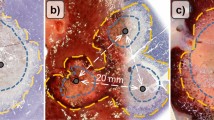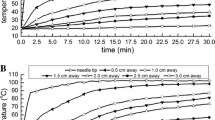Abstract
Radiofrequency (RF) ablation has become an important means of treatment of non-resectable primary and metastatic liver tumours. Recurrence of treated tumours is associated with cancer cell survival next to blood vessels. The paper examines the performance of classical monopolar, and two configurations of bipolar, RF ablation using a LeVeen ten-prong catheter. Finite element method models of monopolar and bipolar configurations were created at 5 mm distance from a vessel of the size of a typical portal vein (10 mm diameter). In one bipolar configuration, the probes were oriented in the same axial direction (asymmetric configuration); in the second bipolar configuration, the two probes were facing each other (symmetric configuration). The distribution of temperature and current density was analysed for three different flow conditions: normal flow, reduced flow due to portal hypertension and high flow. For normal flow, the distance between the formed coagulation zone and the blood vessel was 1.8 mm for monopolar, 1 mm for asymmetric bipolar, and 0.2 mm for symmetric bipolar, configurations. Symmetric bipolar RF ablation creates coagulation zones significantly closer to blood vessels compared with monopolar RF ablation. This may reduce tumour cell survival next to blood vessels and reduce recurrence rates.
Similar content being viewed by others
References
Arkin, H., Xu, L. X., andHolmes, K. R. (1994): ‘Recent developments in modeling heat transfer in blood perfused tissues’,IEEE Trans. Biomed. Eng.,41, pp. 97–107
Burdio, F., Guemes, A., Burdio, J. M., Castiella, T., De Gregorio, M. A., Lozano, R., andLivraghi, T. (1999): ‘Hepatic lesion ablation with bipolar saline-enhanced radiofrequency in the audible spectrum’,Acad. Radiol.,6, pp. 680–686
Chato, J. (1980): ‘Heat transfer to blood vessels’,ASME Trans. Biomed. Eng.,102, pp. 110–118
Cioni, G., D'alimonte, P., Cristani, A., Ventura, P., Abbati, G., Tincani, E., Romagnoli, R., andVentura, E. (1992): ‘Duplex-Doppler assessment of cirrhosis in patients with chronic compensated liver disease’,J. Gastroenterol. Hepatol.,7, pp. 382–384
Curley, S. A., Davidson, B. S., Fleming, R. Y., Izzo, F., Stephens, L. C., Tinkey, P., andCromeens, D. (1997): ‘Laparoscopically guided bipolar radiofrequency ablation of areas of porcine liver’,Surg. Endosc.,11, pp. 729–733
Curley, S. A., Izzo, F., Delrio, P., Ellis, L. M., Granchi, J., Vallone, P., Fiore, F., Pignata, S., Daniele, B., andCremona, F. (1999): ‘Radiofrequency ablation of unresectable primary and metastatic hepatic malignancies’,Ann. Surg.,230, pp. 1–8
Delva, E., Camus, Y., andNordlinger, B. (1989): ‘Vascular occlusions for liver resections’,Ann. Surg.,209, pp. 297–304
Ebbini, E. S., Umemura, S.-I., Ibbini, M., andCain, C. A. (1988): ‘A cylindrical-section ultrasound phased-array applicator for hyperthermia cancer therapy’,IEEE Trans. Biomed. Eng.,35, pp. 561–572
Gazelle, G. S., Goldberg, S. N., Solbiati, L., andLivraghi, T. (2000): ‘Tumor ablation with radio-frequency energy’,Radiology,217, pp. 633–646
Gillams, A. R., andLees, W. R. (1999): ‘The importance of large vessel proximity in thermal ablation of liver tumours’,RSNA 1999, Chicago, IL, USA
Goldberg, S. N., Hahn, P. F., Halpern, E. F., Fogle, R. M., andGazelle, G. S. (1998a): ‘Radio-frequency tissue ablation: effect of pharmacologic modulation of blood flow on coagulation diameter’,Radiology,209, pp. 761–767
Goldberg, S. N., Hahn, P. F., Tanabe, K. K., Mueller, P. R., Schima, W., Athanasoulis, C. A., Compton, C. C., Solbiati, L., andGazelle, G. S. (1998b): ‘Percutaneous radiofrequency tissue ablation: does perfusion-mediated tissue cooling limit coagulation necrosis?’,J. Vasc. Interv. Radiol.,9, pp. 101–111
Gray, S. (1990): ‘Gray's anatomy’ (Vintage Books, New York, 1990)
Haemmerich, D., Staelin, S. T., Tungjitkusolmun, S., Lee, F. T. Jr., Mahvi, D. M., andWebster, J. G. (2001): ‘Hepatic bipolar radiofrequency ablation between separated multiprong electrodes’,IEEE Trans. Biomed. Eng.,48, pp. 1145–1152
Haemmerich, D., Tungjitkusolmun, S., Staelin, S. T., Lee, F. T., Jr., Mahvi, D. M., andWebster, J. G. (2002): ‘Finite-element analysis of hepatic multiple probe radio-frequency ablation’,IEEE Trans. Biomed. Eng.,49, pp. 836–842
Jiao, L. R., Hansen, P. D., Havlik, R., Mitry, R. R., Pignatelli, M., andHabib, N. (1999): ‘Clinical short-term results of radiofrequency ablation in primary and secondary liver tumors’,Am. J. Surg.,177, pp. 303–306
Kew, M. C. (1985): ‘The development of hepatocellular carcinoma in humans’,Cancer Surv.,5, pp. 719–739
Lu, D. S., Raman, S. S., Vodopich, D. J., Wang, M., Sayre, J., andLassman, C. (2002):Lu, D. S., Wang, M. P., Vodopich, D. J., andRaman, S. S. (2000): ‘Effect of vessel size on creation of hepatic radiofrequency lesions in pigs: assessment of the “heat sink” effect’,Am. J. Roentgenol.,178, pp. 147–156
McGahan, J. P., Gu, W.-Z., Brock, J. M., Tesluk, H., andJones, C. D. (1996): ‘Hepatic ablation using bipolar radiofrequency electrocautery’,Acad. Radiol.,3, pp. 418–422
McGahan, J. P., andDodd, G. D., III (2001): ‘Radiofrequency ablation of the liver: current status’,AJR,176, pp. 3–16
Panescu, D., Whayne, J. G., Fleischman, S. D., Mirotznik, M. S., Swanson, D. K., andWebster, J. G. (1995): ‘Three-dimensional finite element analysis of current density and temperature distributions during radio-frequency ablation’,IEEE Trans. Biomed. Eng.,42, pp. 879–890
Patterson, E. J., Scudamore, C. H., Owen, D. A., Nagy, A. G., andBuczkowski, A. K. (1998): ‘Radiofrequency ablation of porcine liverin vivo: effects of blood flow and treatment time on lesion size’,Ann. Surg.,227, pp. 559–565
Pennes, H. H. (1948): ‘Analysis of tissue and arterial blood temperatures in resting forearm’,J. Appl. Phys.,1, pp. 93–122
Rossi, S., Di Stasi, M., Buscarini, E., Quaretti, P., Garbagnati, F., Squassante, L., Paties, C. T., Silverman, D. E., andBuscarini, L. (1996): ‘Percutaneous RF interstitial thermal ablation in the treatment of hepatic cancer’,Am. J. Roentgenol.,167, pp. 759–768
Sapareto, S. A., andDewey, W. C. (1984): ‘Thermal dose determination in cancer therapy’,Int. J. Radiat. Oncol. Biol. Phys.,10, pp. 787–800
Solbiati, L., Ierace, T., Goldberg, S. N., Sironi, S., Livraghi, T., Fiocca, R., Servadio, G., Rizzatto, G., Mueller, P. R., Del Maschio, A., andGazelle, G. S. (1997): ‘Percutaneous US-guided radiofrequency tissue ablation of liver metastases: treatment and follow-up in 16 patients’,Radiology,202, pp. 195–203
Valvano, J. W., Cochran, J. R., andDiller, K. R. (1985): ‘Thermal conductivity and diffusivity of biomaterials measured with self-heating thermistors’,Int. J. Thermophys.,6, pp. 301–311
Wright, A. W., Lee, F. T., Jr., Johnson, C. D., andMahvi, D. M. (2001): ‘Microwave ablation of hepatic tissue: simultaneous use of multiple probes results in large areas of tissue necrosis’,RSNA 2001, Chicago, IL, USA
Author information
Authors and Affiliations
Corresponding author
Rights and permissions
About this article
Cite this article
Haemmerich, D., Wright, A.W., Mahvi, D.M. et al. Hepatic bipolar radiofrequency ablation creates coagulation zones close to blood vessels: A finite element study. Med. Biol. Eng. Comput. 41, 317–323 (2003). https://doi.org/10.1007/BF02348437
Received:
Accepted:
Issue Date:
DOI: https://doi.org/10.1007/BF02348437




